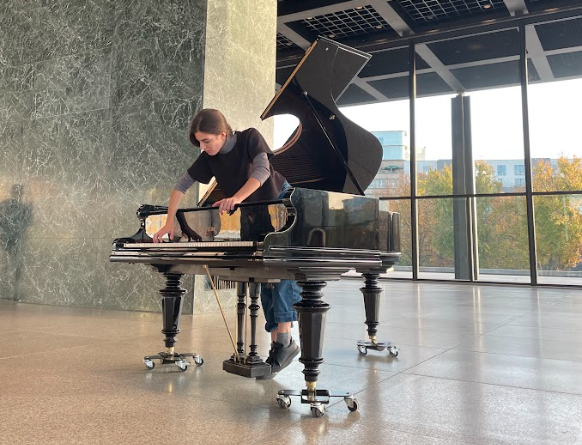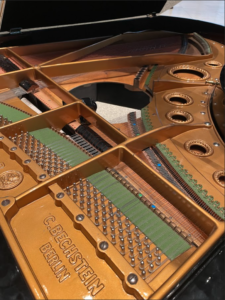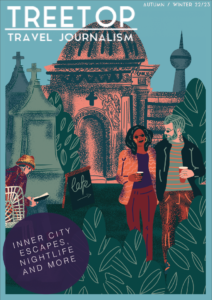Allora and Calzadilla at the Neue Nationalgalerie

Allora and Calzadilla at the Neue Nationalgalerie
Stop, Repair, Prepare
By Agustina Bullrich
As autumn starts to peel the outside world, Allora and Calzadilla’s performance at the Neue Nationalgalerie offers the opposite movement. Once you access the huge lobby, you can see it on the other end. It’s a C. Bechstein three legged piano with a large hole in its case and four wheels in each leg. It’s a young woman, next to the piano, waiting for more people to gather around until it’s time to start. She then lowers her back and gets inside the piano, the performance has begun. She reaches for the keys and Beethoven´s Ode to Joy starts filling the space. After a few minutes, there’s a pause, her feet and her body lean forward and the piano-woman starts to move through the iconic Mies van der Rohe’s glass hall.
The performance, created by the Puerto Rico-based artist duo Allora and Calzadilla and titled “Stop, Repair, Prepare: Variations on Ode to Joy for a prepared piano” explores the complexity and internal structure of Beethoven´s Ninth Symphony final movement, which may be the most popular piece in the history of classical music. The physical limitations created by the hole, which eliminates two octaves and the challenge of reaching across the piano and playing upside down and backward, point to the artists’ intention of deconstructing this musical emblem. Its fascinating and complicated history includes being used over the last couple of centuries by opposing ideologies such as Nazi Germany and anti fascist Spanish Second Republic.
Currently the anthem of the European Union, in 1974 this musical piece was adopted by apartheid-prone Rhodesia as their national anthem, performed in 1989 as part of a celebration of the fall of the Berlin Wall and one of the few pieces of Western music accepted by the Chinese during the Cultural Revolution. Its same origins are embedded in a conflict, and it has been mostly considered as a statement of freedom and universal brotherhood since its premiere in 1824, in the repressive political environment of Europe after the Congress of Vienna.

of the Neue Nationalgalerie and curator of this performance, by taking a close look at the musical structure of the score, Allora and Calzadilla illuminate the complexity of ideological contexts in which this symphony has been used, at times completely contradicting the ideals that this musical treatise was supposed to represent. According to Biesenbach, “in the current situation, in which Europe is once again in conflict, the question of who will be involved in the continental embrace seems more urgent than ever.”
The piano-sculpture moves across space and the audience moves with and around it, creating fleeting shapes that resemble those of migrating birds, mapping a territory intertwined by bodies and musical notes. It doesn’t seem to have a preconceived trajectory, but one that’s created by the movement itself, and in that movement the Nationalgalerie hall is activated and transformed. Once on the other end of the building, it starts its return toward the corner where it started and when it arrives, it stops. Now the pianist stands with her back to the south corner of the building where the sun is setting. One hour later a similar performance will take place, with a different audience and mapping a complete new and diverse territory.
During this one-month exhibition, the performance is inhabited by the following pianists: Ben Cruchley, Paolo Gorini, Eleni Mitrousia, Ido Ramot, Galina Ryzhikova, Marcin Wieczorek. Musical Director: Luca Ieracitano.
Potsdamer Str. 50, 10785 Berlin
Words and photos by Agustina Bullrich
This article was part of our Autumn / Winter 22/23 magazine:

Treetop travel journalism runs study abroad projects in Berlin
